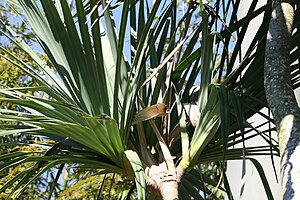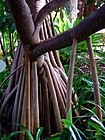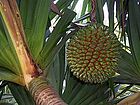Note: This is a project under development. The articles on this wiki are just being initiated and broadly incomplete. You can Help creating new pages.
Pandanus utilis
Pandanus utilis, the common screwpine is, despite its name, a monocot and not a pine. It is native to Madagascar and naturalised in Mauritius and the Seychelles.
Contents
- 1 Uses
- 2 Parts Used
- 3 Chemical Composition
- 4 Common names
- 5 Properties
- 6 Habit
- 7 Identification
- 8 List of Ayurvedic medicine in which the herb is used
- 9 Where to get the saplings
- 10 Mode of Propagation
- 11 How to plant/cultivate
- 12 Commonly seen growing in areas
- 13 Photo Gallery
- 14 References
- 15 External Links
Uses
Parts Used
Chemical Composition
utilis leaves, 19 compounds were obtained, consisting of seven triterpenoids (1-7), five steroids (8-12), four cyclohexenone derivatives (13-16), two benzenoid glycosides (17 and 18), and one lignan (19). [1]
Common names
| Language | Common name |
|---|---|
| Kannada | |
| Hindi | |
| Malayalam | |
| Tamil | |
| Telugu | |
| Marathi | NA |
| Gujarathi | NA |
| Punjabi | NA |
| Kashmiri | NA |
| Sanskrit | |
| English | Bacona |
Properties
Reference: Dravya - Substance, Rasa - Taste, Guna - Qualities, Veerya - Potency, Vipaka - Post-digesion effect, Karma - Pharmacological activity, Prabhava - Therepeutics.
Dravya
Rasa
Guna
Veerya
Vipaka
Karma
Prabhava
Habit
Identification
Leaf
| Kind | Shape | Feature |
|---|---|---|
| Simple | Leaves arranged spirally in 3 series | crowded towards the top of stems, simple, without petiole but with broad clasping base, linear, up to 2 m long, but shorter on old trees, 3–11 cm broad, tapering in a long point at apex. |
Flower
| Type | Size | Color and composition | Stamen | More information |
|---|---|---|---|---|
| Unisexual | cream white | male flowers odorous, with 8–12 stamens inserted pseudo-umbellately on slender columnal excrescences 10–15 mm long; female flowers with 3–8-celled ovary crowned by a sessile stigma. |
Fruit
| Type | Size | Mass | Appearance | Seeds | More information |
|---|---|---|---|---|---|
| Simple Fruit | dome-shaped, compressed, angular drupe arranged in a pendulous, long-peduncled | subglobose syncarp 15–20 cm in diameter, consisting of up to 200 drupes, each up to 3.5 cm × 4 cm × 2 cm, pyrene 3–8-celled, containing several seeds. Seeds endospermous, retained within the endocarp. | yellow when ripe, upper half free, base with a purple or red band | {{{6}}} |
Other features
List of Ayurvedic medicine in which the herb is used
Where to get the saplings
Mode of Propagation
How to plant/cultivate
Pandanus utilis can be propagated by seeds, but these are recalcitrant. Pre-soaking of the seeds for 24 hours before sowing is recommended for Pandanus in general. The germination rate is usually over 50%. Seedlings emerge about 4 months after sowing. After 12–16 months they are 20–40 cm tall and ready to be planted out. Propagation by stem cuttings and suckers is also possible. In Réunion, planting in April or May at spacings of 1.5–3 m is recommended. [3]




